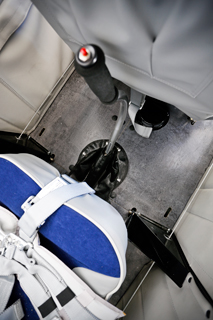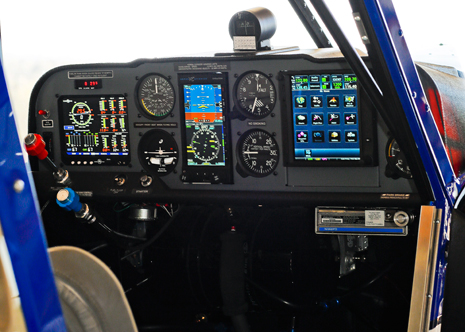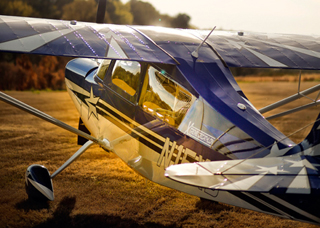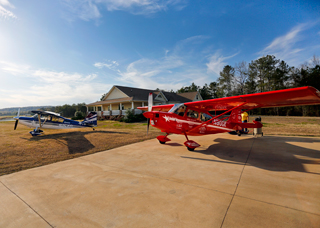Photography by Chris Rose
Now the 180-horsepower Super Decathlon has a bigger sibling—the 210-horsepower American Champion Xtreme features newly designed ailerons in addition to the Lycoming AEIO-390 engine. You can punch deeper holes in the sky, flying straight up, and roll at 120 degrees per second instead of 90.

Redesigned ailerons are big news, almost as big as the more powerful engine. The ailerons are thicker. The front of the aileron protrudes above the wing and creates a low-pressure area that reduces stick forces. The trailing edge is blunter. It took several tries to get it right. The result is, no more spades. The Super Decathlon uses shovel-like attachments on the bottom of the ailerons called spades that give a pilot the equivalent of power steering in a car. The Super Decathlon will continue in production. The spade removal and other minor upgrades to the airplane were mainly done to save weight; the Lycoming 390 is 40 pounds heavier than the 180-horsepower Lycoming AEIO-360 used on the Super Decathlon.
The use of exposed (at the front end), so-called “balance” ailerons gets rid of all the gap covers and wing-gap seals on the older Decathlon, and between that and the spades, saves 14 pounds of weight. The composite MT propeller is 15 pounds lighter than the two-blade aluminum Hartzell propeller used on the Super Decathlon.

“We’ve also redesigned the wing tips,” American Champion engineer, test pilot, and aerobatic instructor Jody Bradt said. “They’re three pounds lighter. They’re clipped so the wingspan is shortened from 32 feet to 30.8 feet. The 390 engine has a 76-inch propeller, so we went up two inches in diameter [compared to the Super Decathlon prop]. That meant the gear legs had to get longer. They are an inch longer and they’re dual-tapered, both in thickness and in width. That saves a pound and a half over the old gear legs. In the interior of the airplane we got rid of the carpet and got rid of the Russian birch plywood and went to a carbon fiber-balsa-fiberglass composite laminate. That saves eight pounds in just the floorboards and an additional four pounds without the carpet.” The longer gear legs mean you might need to S-turn during the taxi, although forward visibility on the ground is still among the best in the tailwheel fleet.

The end result was that while the new engine added 40 pounds, weight savings subtracted 50 pounds. The aircraft felt slightly heavier in pitch, as might be expected.
You’ll notice two things when you fly the Decathlon. It continues upward further during a vertical climb, such as when doing a hammerhead maneuver, and it is fast. In the older Decathlon, having excessive speed wasn’t much of an issue; in fact, you need to dive just to reach the entry speed for some maneuvers. Not so with the Xtreme, which can enter a loop from level flight—just like the powerhouse aerobatic aircraft used by top airshow stars.
The Super Decathlon can come out of a maneuver, such as a loop, going 140 miles an hour, but with the Xtreme you’re about 20 miles an hour faster. “The airplane wants to fly 160 or 170,” Bradt said, “so you have to enter maneuvers slower just because it retains its energy more. In this airplane, you’re going to be flying level and enter a loop, as opposed to diving for that airspeed.”
Maybe entering maneuvers isn’t your thing, although you’ll be proud of yourself if you at least learn to spin to a heading. It’s a fun way to get over any fear of stalls. Still, you have a hamburger getter that will speed towards that distant McDonalds at 126 to 133 knots, according to my flight test. (The aircraft was originally certified in miles per hour.) At the higher speed the JPI EDM 930 engine and fuel monitor ($9,200 installed) showed 78-percent power and a fuel burn of 14.5 gallons per hour. The factory promises that if you reduce power to 75 percent you’ll see a fuel burn of 12 gallons per hour, or you could slow to 115 knots (55 percent power) and burn only 7.2 gallons per hour, according to factory numbers. That way, you could afford the chocolate shake.
 I performed my old spin, loop, and slow-roll routine and found the aircraft behaving much like the Super Decathlon I had used in a beginners’ contest. Takeoff is much faster than the Super Decathlon. At maximum gross weight we climbed 200 feet per minute faster than the Super Decathlon, or 1,400 feet per minute.
I performed my old spin, loop, and slow-roll routine and found the aircraft behaving much like the Super Decathlon I had used in a beginners’ contest. Takeoff is much faster than the Super Decathlon. At maximum gross weight we climbed 200 feet per minute faster than the Super Decathlon, or 1,400 feet per minute.
Left to its own desires, the Decathlon doesn’t really want to spin. I waited two seconds too long to apply full left rudder for the spin entry as the aircraft slowed with power at idle, and the Xtreme sat there for an instant, as if to ask, “Are we trying to stall on purpose, or trying to avoid it?” (Answer: On purpose.) Halfway through the one-turn spin I applied half-opposite rudder, and reaching my original heading, pushed full opposite rudder and snapped the stick forward to break the stall. Stops on a dime. I dispensed with forming a perfectly vertical down-line, leveled, and went into the loop a little too slowly—that is, I didn’t pull hard enough on the entry. I saw the manifold pressure setting was low, added some power, and went over the top inverted per the plan, but in slow flight, which was fun. Will he fall out of the loop or not? I made it.
Airshow star Greg Koontz, an American Champion dealer who now uses the Xtreme Decathlon in his act, was kind enough to fly the Xtreme seen here for our photo shoot from his training school’s grass runway in Ashville, Alabama. (His other act uses a Cub and features The Alabama Boys comedy routine in which he gets caught riding an airplane he supposedly can’t fly, but saves the day by landing on a moving truck.)
 After a week with the Xtreme, he had this reaction: “I feel it is going to take most Super Decathlon pilots a little while to get used to the [the Xtreme’s heavier] aileron break-out forces. They are not too heavy, just a different feel. It takes a little more pressure to get the aileron started than to finish the full travel. I find myself being jerky on point rolls because as I release the ailerons, the pressure increases near the centering. This is still catching me a bit off guard, resulting in a wobble. For me, keeping energy [during] low-level acro is much easier. In fact, I am not well adjusted yet and I find myself with a lot of excess speed and/or altitude since I have a hard time resisting being very stingy with energy.”
After a week with the Xtreme, he had this reaction: “I feel it is going to take most Super Decathlon pilots a little while to get used to the [the Xtreme’s heavier] aileron break-out forces. They are not too heavy, just a different feel. It takes a little more pressure to get the aileron started than to finish the full travel. I find myself being jerky on point rolls because as I release the ailerons, the pressure increases near the centering. This is still catching me a bit off guard, resulting in a wobble. For me, keeping energy [during] low-level acro is much easier. In fact, I am not well adjusted yet and I find myself with a lot of excess speed and/or altitude since I have a hard time resisting being very stingy with energy.”
You’ll notice the payload with full fuel (in the specification box above) when flying aerobatics is only 215 pounds. First of all you wouldn’t fly maneuvers for four hours, so full fuel is not necessary. Second, that particular aircraft has the highest empty weight of the four Xtremes built so far because of avionics. Others were closer to 1,330 and 1,340 pounds, while the one pictured here has an empty weight of 1,355 pounds. The Pennsylvania owner stocked the cockpit with an Aspen Avionics Evolution EFD 1000 Pro primary flight display ($11,500 installed), a Garmin GTN 750 GPS nav/com multifunction display linked with a Garmin GMA 35 audio panel plus a Garmin GTX 33 transponder ($30,232 for all three installed), and a Garmin GDL 88 series ADS-B datalink for weather and traffic ($5,841 installed).
While that aircraft may spend its life going cross country faster than a Cessna 172, he added a Hooker Harness aerobatic belt system just in case a loop calls his name (preferably before the hamburger and milkshake, but you just never know).
Email [email protected].
Italian paint scheme designer sought worldwide
The unique paint scheme for the Xtreme shown with this article was created by Mirco Pecorari of Aircraft Studio Design in Modena, Italy, located halfway between Florence and Milan. Pecorari has created paint schemes for the Nemesis NXT built by Jon Sharp, the Relentless Reno air racer; airshow pilots around the world; and for Italy’s Pioneer Team four-ship airshow act. He coordinates aircraft paint schemes with each performer’s uniform and then keeps the same look as he designs the performer’s website.—AKM
The ‘Greg’ Compound
Home on the range doesn’t always mean cattle
 To be clear from the start, airshow star Greg Koontz and his wife Cora do not run a bed and breakfast that is open to the public. You first need to be an aerobatic student with a need for a room—and food—while you are in training. There are two rooms in the couple’s home at Ashville, Alabama, dedicated to students. There’s one hotel in the tiny town, 45 minutes northeast of Birmingham, but staying there means you’d miss your breakfast ground school briefing with the instructor.
To be clear from the start, airshow star Greg Koontz and his wife Cora do not run a bed and breakfast that is open to the public. You first need to be an aerobatic student with a need for a room—and food—while you are in training. There are two rooms in the couple’s home at Ashville, Alabama, dedicated to students. There’s one hotel in the tiny town, 45 minutes northeast of Birmingham, but staying there means you’d miss your breakfast ground school briefing with the instructor.
Two Decathlons were traveling from the American Champion factory in Rochester, Wisconsin, to Lakeland, Florida, and we needed to intercept one or both of them for this story and photo shoot. The best place to do that, factory official Jerry Mehlhaff Jr., said, was to go to the “Koontz ranch.”
It’s not so much a ranch as it is a beautiful private home with a restricted grass runway—an approved aerobatic box exists just above it—plus some large hangars. I mentioned to Cora that I was going to call it the Koontz Compound in this article, but she suggested a more accurate title is “Greg’s Compound.” Koontz actually calls it Sky Country Lodge.
One of the hangars is named “The Toy Box.” It houses two beautiful Cubs, an aerobatic Bücker Jungmeister biplane, and Greg’s Decathlon that is used in his airshow act. The act is an inspiration to pilots wanting to loop and roll in a slow and simple general aviation aircraft. The pristine Cubs are Greg’s toys, but are like the one used for his “Alabama Boys” act in which he pretends to be a nonpilot who has gotten trapped in an airplane during an accidental takeoff, and eventually lands safely atop a speeding pickup truck. The actual Cub used in the show is locked up in a trailer, ready for the next performance.
“When we moved way out here in the country and left the big city, we said, where are we going to put the students? They come from out of town, mostly,” Koontz said. “We made the house a bed and breakfast. It created an atmosphere of training that everybody seems to like, and we like. It’s not like showing up at an FBO at nine o’clock and taking a lesson. You’re with me all day.”
People come not only from out of town, but from out of the country. It’s a dream he and Cora (also a pilot) have had since high school.
Courses range from beginning aerobatics and tailwheel training through the Sportsman level of competition aerobatics.
The $695-a-day rate includes three meals, the room, and two flights a day. But why move way out in the country? “To get away from the big city,” the Alabama boy replied.—AKM
SPEC SHEET
Xtreme Decathlon
BASE PRICE: $209,900
PRICE AS TESTED: $276,652
SPECIFICATIONS
Powerplant | 210 hp Lycoming AEIO-390-A1B6
Recommended TBO | 1,400 hr
Propeller | 2 blade MT, MTV-15-B-C/193-25
Length | 22 ft 11 in
Height | 7 ft 7 in
Wingspan | 30 ft 9 in
Wing area | 164 sq ft
Wing loading | 11.9 lb/sq ft
Power loading | 9.3 lb/hp
Seats | 2
Cabin length | 8 ft 10 in
Cabin width | 2 ft 6 in
Cabin height | 3 ft 11 in
Empty weight | 1,320 lb
Empty weight, as tested | 1,355 lb
Max gross weight | Normal 1,950 lb (aerobatic 1,800 lb)
Useful load | 630 lb (aerobatic 480 lb)
Useful load, as tested | Normal 595 lb (aerobatic 445 lb)
Payload w/full fuel | Normal 390 lb (aerobatic 240 lb)
Payload w/full fuel, as tested | Normal 355 lb (aerobatic 205 lb)
Fuel capacity, std | 41.5 gal (40 gal usable)
249 lb (240 lb usable)
Inverted fuel | 2 min
Baggage capacity | 100 lb, 10.4 cu ft
PERFORMANCE
Aerobatic limit load | +6, -5
Takeoff distance, ground roll | 520 ft
Takeoff distance over 50-ft obstacle | 957 ft
Max demonstrated crosswind component | 17 kt
Rate of climb, sea level | 1,498 fpm
Max level speed, sea level | 161 kt
Cruise speed/endurance w/45-min rsv, (fuel consumption)
@ 75% power, best economy | 149 mph/2.6 hr
6,000 ft (72 pph/12 gph)
@ 55% power, best economy | 133 mph/4.8 hr
9,000 ft (43 pph/7.2 gph)
Service ceiling | 20,000 ft
Landing distance over 50-ft obstacle | 1,346 ft
Landing distance, ground roll | 542 ft
LIMITING AND RECOMMENDED AIRSPEEDS
VX (best angle of climb) | 57 mph IAS
VY (best rate of climb) | 81 mph IAS
VA (design maneuvering) | 110 mph IAS
VNO (max structural cruising) | 160 mph CAS
VNE (never exceed) | 200 CAS
VR (rotation) | 58 mph IAS
VSO | 58 mph IAS
FOR MORE INFORMATION
Contact American Champion Aircraft Corporation, 32032 Washington Avenue Rochester, Wisconsin 53167; phone 262/534-6315.
All specifications are based on manufacturer’s calculations. All performance figures are based on standard day, standard atmosphere, sea level, gross weight conditions unless otherwise noted.
EXTRA
While savings were found to make up for the extra engine weight, the aircraft is still heavier in pitch. It comes from tossing that heavier engine around during aerobatic maneuvers.




